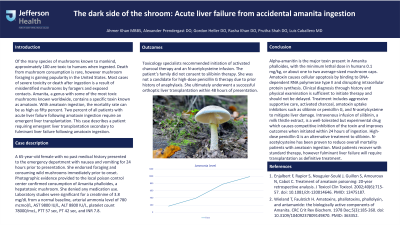Sunday Poster Session
Category: Liver
P1102 - The Dark Side of the Shroom: Acute Liver Failure from Accidental Amanita Ingestion
Sunday, October 22, 2023
3:30 PM - 7:00 PM PT
Location: Exhibit Hall

Has Audio
.jpg)
Ahmer Khan, MBBS
Albert Einstein Medical Center
Philadelphia, PA
Presenting Author(s)
Ahmer Khan, MBBS, Alexander Prendergast, DO, Gordon Heller, DO, Rasha Khan, DO, Prutha Shah, DO, Luis Caballero, MD
Albert Einstein Medical Center, Philadelphia, PA
Introduction: Of the many species of mushrooms known to mankind, approximately 100 are toxic to humans when ingested. Death from mushroom consumption is rare, however mushroom foraging is gaining popularity in the United States. Most cases of severe toxicity or death after ingestion is a result of misidentified mushrooms by foragers and exposed contacts. Amanita, a genus with some of the most toxic mushrooms known worldwide, contains a specific toxin known as amatoxin. With amatoxin ingestion, the mortality rate can be as high as fifty percent. Two percent of all patients with acute liver failure following amatoxin ingestion require an emergent liver transplantation.This case describes a patient requiring emergent liver transplantation secondary to fulminant liver failure following amatoxin ingestion.
Case Description/Methods: A 65-year-old female with no past medical history presented with nausea and vomiting for 24 hours prior to presentation. She endorsed foraging and consuming wild mushrooms immediately prior to onset. Photographic evidence provided to the local poison control center confirmed consumption of Amanita phalloides, a hepatotoxic mushroom. She denied any medication use. Laboratory studies were significant for a creatinine of 3.8 mg/dL from a normal baseline, arterial ammonia level of 780 mcmol/L, AST 9800 IU/L, ALT 8800 IU/L, platelet count 78000/mcL, PTT 57 sec, PT 42 sec, and INR 7.8.
Toxicology specialists recommended initiation of activated charcoal therapy and an N-acetylcysteine infusion. She was not a candidate for high-dose penicillin G therapy due to prior history of anaphylaxis. She ultimately underwent a successful orthoptic liver transplantation within 48 hours of presentation.
Discussion: Amatoxin causes cellular apoptosis by binding to DNA-dependent RNA polymerase type II and disrupting intracellular protein synthesis. Clinical diagnosis through history and physical examination is sufficient to initiate therapy and should not be delayed. Treatment includes aggressive supportive care, activated charcoal, amatoxin uptake inhibitors such as silibinin or penicillin G, and N-acetylcysteine. Intravenous infusion of silibinin, a milk thistle extract, is a well-tolerated but experimental drug improves outcomes when initiated within 24 hours of ingestion. N-acetylcysteine has been proven to reduce overall mortality in patients with amatoxin ingestion. Most patients recover with standard therapy, however fulminant liver failure will require transplantation as definitive treatment.
Disclosures:
Ahmer Khan, MBBS, Alexander Prendergast, DO, Gordon Heller, DO, Rasha Khan, DO, Prutha Shah, DO, Luis Caballero, MD. P1102 - The Dark Side of the Shroom: Acute Liver Failure from Accidental Amanita Ingestion, ACG 2023 Annual Scientific Meeting Abstracts. Vancouver, BC, Canada: American College of Gastroenterology.
Albert Einstein Medical Center, Philadelphia, PA
Introduction: Of the many species of mushrooms known to mankind, approximately 100 are toxic to humans when ingested. Death from mushroom consumption is rare, however mushroom foraging is gaining popularity in the United States. Most cases of severe toxicity or death after ingestion is a result of misidentified mushrooms by foragers and exposed contacts. Amanita, a genus with some of the most toxic mushrooms known worldwide, contains a specific toxin known as amatoxin. With amatoxin ingestion, the mortality rate can be as high as fifty percent. Two percent of all patients with acute liver failure following amatoxin ingestion require an emergent liver transplantation.This case describes a patient requiring emergent liver transplantation secondary to fulminant liver failure following amatoxin ingestion.
Case Description/Methods: A 65-year-old female with no past medical history presented with nausea and vomiting for 24 hours prior to presentation. She endorsed foraging and consuming wild mushrooms immediately prior to onset. Photographic evidence provided to the local poison control center confirmed consumption of Amanita phalloides, a hepatotoxic mushroom. She denied any medication use. Laboratory studies were significant for a creatinine of 3.8 mg/dL from a normal baseline, arterial ammonia level of 780 mcmol/L, AST 9800 IU/L, ALT 8800 IU/L, platelet count 78000/mcL, PTT 57 sec, PT 42 sec, and INR 7.8.
Toxicology specialists recommended initiation of activated charcoal therapy and an N-acetylcysteine infusion. She was not a candidate for high-dose penicillin G therapy due to prior history of anaphylaxis. She ultimately underwent a successful orthoptic liver transplantation within 48 hours of presentation.
Discussion: Amatoxin causes cellular apoptosis by binding to DNA-dependent RNA polymerase type II and disrupting intracellular protein synthesis. Clinical diagnosis through history and physical examination is sufficient to initiate therapy and should not be delayed. Treatment includes aggressive supportive care, activated charcoal, amatoxin uptake inhibitors such as silibinin or penicillin G, and N-acetylcysteine. Intravenous infusion of silibinin, a milk thistle extract, is a well-tolerated but experimental drug improves outcomes when initiated within 24 hours of ingestion. N-acetylcysteine has been proven to reduce overall mortality in patients with amatoxin ingestion. Most patients recover with standard therapy, however fulminant liver failure will require transplantation as definitive treatment.
Disclosures:
Ahmer Khan indicated no relevant financial relationships.
Alexander Prendergast indicated no relevant financial relationships.
Gordon Heller indicated no relevant financial relationships.
Rasha Khan indicated no relevant financial relationships.
Prutha Shah indicated no relevant financial relationships.
Luis Caballero indicated no relevant financial relationships.
Ahmer Khan, MBBS, Alexander Prendergast, DO, Gordon Heller, DO, Rasha Khan, DO, Prutha Shah, DO, Luis Caballero, MD. P1102 - The Dark Side of the Shroom: Acute Liver Failure from Accidental Amanita Ingestion, ACG 2023 Annual Scientific Meeting Abstracts. Vancouver, BC, Canada: American College of Gastroenterology.
